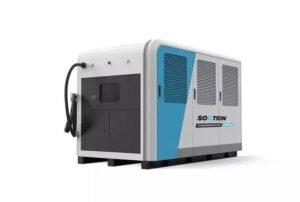With the development of the new Coolant Control Hub max (CCH max), the international automotive supplier FORVIA HELLA is further advancing the centralization of thermal management in electric vehicles. It is based on the Coolant Control Hub developed by FORVIA HELLA, for which FORVIA HELLA has already won customer projects with an order volume in the low to mid three-digit million euro range and which will soon be launched for the first time in Mexico. As a highly integrated system for the thermal management of the drivetrain, battery and interior, the Coolant Control Hub max now relies on an innovative coolant distribution system that enables the cost-efficient use of environmentally friendly refrigerants, reduces the complexity of thermal management and increases the performance of electric vehicles.

“Longer ranges even at very low outside temperatures, shorter charging times and the affordability of electric cars are of central importance for the further market development of electromobility. A major key to this is not least the intelligent design of the thermal management system, We have already proven the benefits of our subsystem solution with the series orders for the Coolant Control Hub to date. Among other things, we owe this to our many years of expertise in the field of actuators and our distinctive system expertise. With the Coolant Control Hub max and its significantly expanded functionalities, we are now taking the next step.”
Jörg Weisgerber, Managing Director Electronics at FORVIA HELLA.
The Coolant Control Hub max primarily utilizes the water-glycol cooling circuit to optimize the temperature of the drivetrain, battery and vehicle interior, consistently reducing the number of components required. This means that the refrigerant system is primarily used to cool and heat the water-glycol circuit. The use of refrigerants can therefore be reduced by more than 80 percent and thus to a minimum. This enables the safe and cost-efficient use of natural and environmentally friendly refrigerants such as propane or CO2, PFAS chemicals can be completely dispensed with.
The decisive factor here is intelligent and needs-based distribution in the water-glycol circuit. The Coolant Control Hub max, for example, uses a new type of individual cooling system that allows optimally adapted target temperatures for the vehicle interior and/or the battery in a joint water-glycol circuit, respectively. The Coolant Control Hub max solves the need for efficient heating of the interior and battery with a flexible heat pump system that utilizes all available heat sources such as the ambient air, the drivetrain and the refrigerant system itself. For this purpose, the refrigerant system is equipped with a self-heating function (“self-heating mode”) that enables it to generate sufficient heat internally as soon as other heat sources are not available to the required extent.
All in all, the Coolant Control Hub max eliminates half of the coolant and refrigerant valves currently required; electric auxiliary heaters are also no longer needed. Compared to conventional centralized thermal management systems, the Coolant Control Hub max can reduce the weight of the overall system by around 20 percent. In this way, CO2 emissions can be reduced and ranges increased, also in conjunction with the lower resource requirements.
- New technology: innovative individual cooling of the vehicle interior and battery in a joint water-glycol circuit
- Environmentally friendly alternative: Switch to propane or CO2 to completely avoid PFAS chemicals
- System approach: reduced complexity by halving the number of cooling and refrigerant valves required, additional electric heaters eliminated
- Savings: 20 percent less weight in the overall system reduces CO2 emissions and increases ranges


